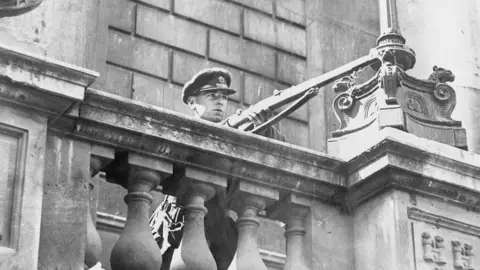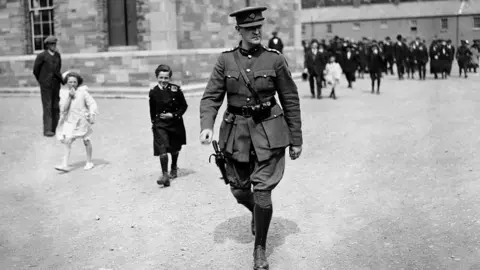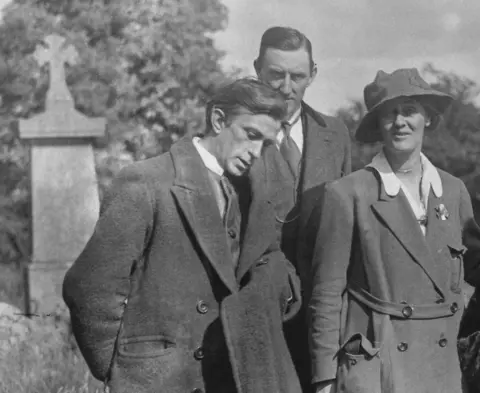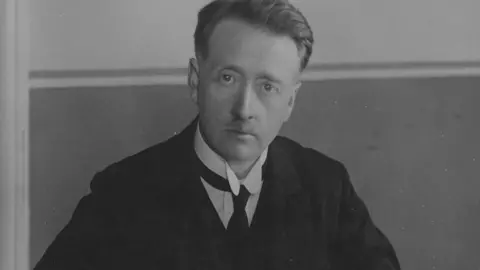Ireland 1922: The key figures in the new Irish Free State
 G#
G#At the start of 1922, Ireland was in a state of relative peace after years of bloody fighting.
A truce, which came into effect in July 1921, had halted the Irish War of Independence, and the Anglo-Irish Treaty agreed between the United Kingdom and negotiators from the Irish republican breakaway government was signed that December.
But the treaty, which created an independent Irish Free State, was highly controversial and was only narrowly passed by the Dáil (Irish parliament) in January 1922 after a series of stormy debates.
It set Ireland on the path for further conflict, and in June a civil war broke out between pro-treaty and anti-treaty forces that would drag on for 11 months and cost the lives of many major players in the Irish independence movement.
Here are some of those who played a key role in the events of 1922.

 Getty Images
Getty ImagesMichael Collins
Michael Collins first rose to prominence during the Easter Rising of 1916 and two years later he was elected as an Irish MP in 1918.
He served as a minister in the first Dáil Éireann but he considered himself a soldier rather than a politician, and it was military leadership that brought him renown.
He led the IRA during the War of Independence with Great Britain, directing the outnumbered rebels to conduct a guerrilla war against the British forces.
He was then part of the Irish delegation that went to London and negotiated and agreed the Anglo-Irish Treaty.
Collins appeared to know of the danger the treaty had placed him in, famously remarking that by signing it he had signed his death warrant.
However he also famously said that while the treaty fell short of the fully independent Irish republic that he wanted, it provided Ireland with "the freedom to win freedom".
In the tempestuous and bitter debates over whether the Dáil should ratify the treaty, Collins urged delegates to do so, and ultimately they voted 64 to 57 in favour.
But this led to a substantial number of delegates who opposed the treaty, including Éamon De Valera, to withdraw from the Dáil.
In mid-January, Collins became chairman of the new provisional government - effectively the prime minister.
But when the deep divisions over the treaty descended into civil war in July 1922, Collins headed the pro-treaty National Army against their anti-treaty opponents, the majority of whom had served alongside Collins in the IRA in the War of Independence.
In August, while in his native County Cork, his convoy was ambushed by anti-treaty forces at Béal na Bláth, and he was shot dead.

 General Photographic Agency
General Photographic AgencyÉamon De Valera
New York-born, De Valera is probably the most influential Irish politician of the 20th Century - he was central to the formation of an Irish Free State and, as its leader, the evolution of it into an independent republic.
He first came to prominence in the Easter Rising, as a rebel forces commandant.
He was captured and sentenced to death, but was released following public backlash to the initial wave of executions and his American birth at a time when Britain was trying to convince the United States to enter World War One.
De Valera subsequently became one of the leading figures in the surging independence movement and, in 1917, was elected president of Sinn Féin.
In 1919, after dominating the Irish general election, the party chose not to take its seats in Westminster, instead forming an Irish parliament (called Dáil Éireann), with De Valera serving as its president.
Following the War of Independence with Britain, De Valera tasked Michael Collins with negotiating the terms of the Anglo-Irish Treaty.
However, he opposed the deal, saying: "If the treaty were accepted [by the electorate], the fight for freedom would still go on, and the Irish people, instead of fighting foreign soldiers, will have to fight the Irish soldiers of an Irish government set up by Irishmen."
He ended up the nominal leader of the anti-treaty forces during the civil war, but in 1923, he was among those on the anti-treaty side who backed a truce.
Shortly afterwards he was arrested by the new Free State government and interned for a year.
However, he abandoned his stance of abstentionism from the Free State Dáil and went on to found Fianna Fáil and become taoiseach (prime minister) in 1932.
Instrumental in transforming the Free State into a republic, he would later serve as president until 1973, two years before his death aged 92.

 Getty Images
Getty ImagesRory O'Connor
In 1916, Rory O'Connor served as a republican intelligence officer during the Easter Rising, and during the War of Independence he was director of engineering for the IRA.
But in 1922, his role opposing the Anglo-Irish Treaty led to his execution, with his death warrant signed by Kevin O'Higgins, for whom he had been best man at his wedding in October 1921.
O'Connor was bitterly opposed to the treaty, which he felt finalised the partition of Ireland.
This led to him, along with a number of other IRA men, breaking away to oppose the treaty militarily.
In April 1922, a 200-strong force occupied the Four Courts in Dublin.
They remained there until June 1922, when the British government lost patience following the assassination of Field Marshal Sir Henry Wilson by the IRA in London.
After Ginger O'Connell, a general in the new Free State Army was captured by O'Connor's garrison, Michael Collins ordered the Four Courts to be shelled, forcing the garrison's surrender on 30 June.
This marked the beginning of the civil war.
On 8 December, O'Connor was executed by firing squad.

Read more about the Anglo-Irish Treaty

 Topical Press Agency
Topical Press AgencyRichard Mulcahy
Like Rory O'Connor, Richard Mulcahy symbolises the bitter divisions of the Irish Civil War.
During the Easter Rising, Mulcahy was second-in-command of a unit which defeated the Royal Irish Constabulary in Ashbourne, County Meath.
He was later interned but after his release he became IRA chief of staff in March 1918, and later that year was elected as an MP and became minister of defence in the new breakaway government.
In these roles he played a key part in directing the War of Independence against British forces, but in 1921 he supported the Anglo-Irish Treaty.
He was once again made minister of defence, this time in the pro-treaty provisional government and in this role he issued an order that any anti-treaty activists carrying arms were liable to be executed.
This led to 77 anti-treaty prisoners being put to death by the new government.
Mulcahy went on to lead the Fine Gael party, and seemed set to become taoiseach at the head of a coalition government in 1948, but one of the smaller parties, Clann na Poblachta, refused to serve under him because of his role in the executions.
He stepped aside and let John A Costello serve as taoiseach while he took up the education brief.

 Getty Images
Getty ImagesWT Cosgrave
By the end of 1922 many of the leading figures in the fight for Irish independence were either dead or fighting on the anti-treaty side.
After the death of Collins, the provisional government needed a new leader and the pro-treaty side opted for WT Cosgrave.
Cosgrave had been active in Sinn Féin since its first convention in 1905, and had served as a councillor for the party on Dublin Corporation from 1909.
He also played an active part in the Easter Rising and was elected as an MP in 1918 before serving in the breakaway government.
With his mix of political experience and commitment to both Irish independence and the pro-treaty cause, he was a suitable fit for the role of chairman of the provisional government.
When the first permanent government of the Irish Free State was formed, he became president of the executive council, or prime minister, and is today regarded as the first taoiseach even though the position did not have that name at the time.
Cosgrave went on to guide the Free State out of the civil war and he led it for the first 10 years of its existence, laying the foundations for a stable, independent country.
